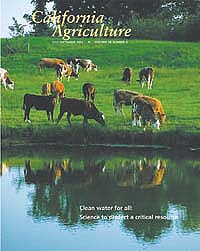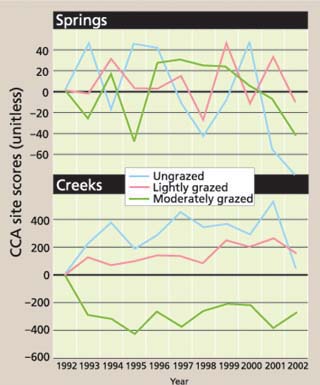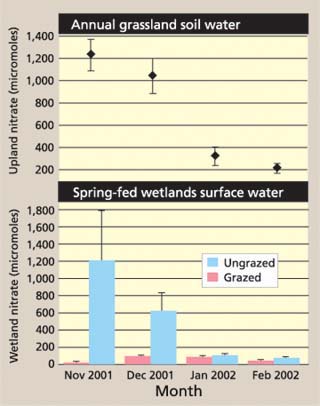All Issues
Letters: October-December 2004
Publication Information
California Agriculture 58(4):180-181.
Published October 01, 2004
PDF | Citation | Permissions
Full text
WHAT DO YOU THINK?
The editorial staff of California Agriculture welcomes your letters, comments and suggestions. Please write to us at calag@ucop.edu or 1111 Franklin St., 6th fl., Oakland, CA 94607. Include your full name and address. Letters may be edited for space and clarity.
Cattle husbandry extractive by nature
The study, “Long-term grazing study in spring-fed wetlands reveals management tradeoffs” by Allen-Diaz et al. (July-Sept. 2004), supposes that time — 10 years here — restores ecosystems approximately to pristine condition. The stream-water nitrate spike is plainly an artifact of disturbance rather than a “natural” pathology. Were this system allowed full recovery time, there is no doubt the types of vegetation would tend to perennials such as bushes and trees, and that the nitrate released to the water would be the level to optimally fertilize the downstream waters. The article's conclusion makes the unsubstantiated assertion that livestock grazing can be of equal impact to natural grazing (such as deer and antelope in this area). I've lived 10 years in proximity to cattle and know that their “footprint” is not redundant to deer. Fundamentally, cattle husbandry will always be extractive; the “perfect” animal for these ecosystems would be what evolved there.
I was born in California, was a resident for 47 years, and am a UC grad. I continue to have an interest and am grateful for issues of California Agriculture.
Stephen Diliberto
Miami, Oklahoma
Lead author Barbara Allen-Diaz responds: In the article, we never state or imply that “time — 10 years here — restores ecosystems approximately to pristine condition.” In fact, we make the point that these systems have been focal points for use by wildlife as long as they've been in existence, and for livestock for the last 150+ years. We also never state or imply that livestock grazing and “natural grazing” are the same. Rather, our goal was to examine and quantify the effects of livestock grazing at particular intensities (including removal) on several spring ecosystem parameters. Our results show that livestock grazing affects different components of the ecosystem differently. And, contrary to popular belief, our data shows that some components, such as nitrate concentrations in spring waters, actually increase with removal of livestock grazing, while biodiversity, for example, is highest with low-intensity grazing. We leave it to readers to render their own opinions about livestock grazing in these systems; we only ask that the readers be informed about the different kinds of responses. We continue to conduct, expand and learn from research in these systems.
Biotech knowledge affects understanding
Congratulations for your leadership in producing the “Fruits of Biotechnology” issue (April-June 2004) and to all of your colleagues who contributed to this excellent publication. In the early 1980s, the California Agriculture publication, “Genetic Engineering of Plants” (Aug. 1982, Vol. 36, No. 8), was acclaimed as a very helpful document for a new field. “Fruits of Biotechnology” is a much-needed step to take this technology to a world desperately in need of it.
It has been difficult to be patient with all of the doubters, especially when their doubts are based on ignorance. Readers of this new publication may still be doubters, but they will now have the knowledge to affect their understanding.
Lowell N. Lewis, Coordinator of Programs
University of California/Catalunya
McGovern reveals ag biotech foes
California agriculture today produces more than twice as much as it did in 1950 on less land. These gains are due to technological advances that have resulted in less hunger and malnutrition due to cheaper and safer food. At the same time, these advances have protected the environment.
There are those that oppose agricultural biotechnology. George McGovern, one of the most liberal presidential candidates, in his book “The Third Freedom,” has the guts to name the opponents of technical agriculture, including genetic engineering. McGovern writes, “I have for years admired the principles and policies of such environmental groups as the Sierra Club and Friends of the Earth…But I believe their opposition to biotechnology as the newly emerging handmaiden of agriculture is both ill-founded and threatening to human survival in the poor countries of the planet.”
Groups such as these are costing California agriculture markets today and have reduced the private research effort in agriculture. Without research, in time California agriculture will lose its technological advantage and markets will be lost to countries with lower labor costs. The California Agriculture writers (April-June 2004) state there are those that oppose agricultural progress but fail to name them or their bedfellows. Let George do it.
Robert J.Buker
Professor, Ohio State University, Retired Vancouver, Wash.
Social vs. plant sciences revisited
In his letter (July-Sept. 2004), Professor Thomas Björkman asks: “How does one get biologists to apply their honed skills at unprejudiced analysis to human systems?” and refers to the article by Julian Alston in the previous California Agriculture (“Horticultural biotechnology faces significant economic and market barriers,” April-June 2004), describing it as “the best teaching tool I have seen for raising the quality of social analysis by biological scientists.” Bjorkman contends that Alston approaches “people factors as behaving just as neutrally as plant pathways.”
Undoubtedly there are similarities between life forms as diverse as plants and humans, which may permit plant scientists to believe they work purely in an atmosphere of neutrality. But the difference between plants and humans constitutes an order of magnitude that is staggering. Human beings are reflexive, and have consciousness and “rationality.” Further, human beings can be contrary and contumacious; when they learn about a social science behavior, some deliberately do the opposite. I haven't heard of any vegetables or fruits having this capacity.
This does not mean that there is no such thing as social science; there is, but we have learned through more than a century and a half of development that there are fundamental differences between the social and natural sciences. We have also learned, through social science investigations, that the natural sciences experience human problems and that, like the social sciences, ostensibly “objective” findings are subject to scientific “negotiation.”
Asking physiologists and horticultural scientists to become social scientists is asking a bit much, although UC had such an opportunity over a decade ago when California Rural Legal Assistance (CRLA) won a suit against UC for conducting research that benefited large-scale industrialized agriculture to the detriment of smaller units of production and farmworkers.
UC fought the suit with great energy and the judge's ruling was reversed on appeal. But before the reversal, Judge Marsh asked the litigants for a remedy following his ruling. CRLA proposed that UC require its agricultural scientists to prepare “social-impact analyses” of the projected benefits of their research proposals, with technical assistance from a new research and evaluation unit. UC rejected this remedy, even though it would have opened a new and still-developing research area, arguing that the suit and the proposed remedy represented an infringement on the principles of academic freedom. This ignored the system by which non-University funds from private sources or semi-governmental ones (such as marketing orders) leveraged university resources for research in the form of faculty salaries, buildings and equipment.
The Alston article ignored the social costs of genetic manipulation. Likewise, most GM enthusiasts ignore them or express the simplistic hope that the methodology for studying plants has applicability to the infinitely more complex problem of understanding human beings and their social creations.
William H. Friedland
Professor Emeritus UC Santa Cruz
Correction
Two figures were published incorrectly in “Long-term grazing study in spring-fed wetlands reveals management tradeoffs” (July-Sept. 2004), on page 145 (fig. 3) and page 147 (fig. 5). The corrected figures have been included in the online PDF version, and appear below. California Agriculture regrets these errors.







